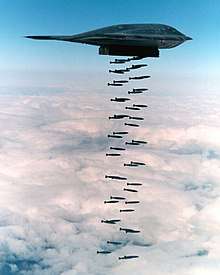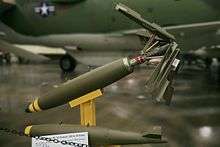Mark 82 bomb
The Mark 82 (Mk 82) is an unguided, low-drag general-purpose bomb, part of the United States Mark 80 series. The explosive filling is usually tritonal, though other compositions have sometimes been used.
| Mark 82 General Purpose (GP) Bomb | |
|---|---|
 Mk 82 bomb as displayed on U.S. Air Force website. | |
| Type | Low-drag general-purpose bomb |
| Place of origin | United States |
| Production history | |
| Designer | General Dynamics |
| Manufacturer | General Dynamics |
| Unit cost | $2,082.50 (in 2001)[1] |
| Variants | GBU-12 Paveway II GBU-38 JDAM |
| Specifications | |
| Mass | 500 pounds (227 kg) |
| Length | 87.4 inches (2.22 m) |
| Diameter | 10.75 inches (273 mm) |
| Filling | Tritonal, Minol (explosive) or Composition H6 |
| Filling weight | 192 pounds (87 kg) |
Development and deployment

With a nominal weight of 500 lb (227 kg), it is the one of the smallest in current service, and one of the most common air-dropped weapons in the world. Although the Mk 82's nominal weight is 500 lb (227 kg), its actual weight varies depending on its configuration, from 510 lb (232 kg) to 570 lb (259 kg). It is a streamlined steel casing containing 192 lb (89 kg) of Tritonal high explosive. The Mk 82 is offered with a variety of fin kits, fuzes, and retarders for different purposes.
The Mk 82 is the warhead for the GBU-12 laser-guided bombs and for the GBU-38 JDAM.
Currently only the General Dynamics plant in Garland, Texas and Nitro-Chem in Bydgoszcz, Poland is Department of Defense-certified to manufacture bombs for the US Armed Forces.
The Mk 82 is currently undergoing a minor redesign to allow it to meet the insensitive munitions requirements set by Congress.

According to a test report conducted by the United States Navy's Weapon System Explosives Safety Review Board (WSESRB) established in the wake of the 1967 USS Forrestal fire, the cooking off time for a Mk 82 is approximately 2 minutes 30 seconds.
More than 4,500 GBU-12/Mk 82 laser-guided bombs were dropped on Iraq during the Persian Gulf War.[2] France requested 1,200 Mk 82s in 2010 to Société des Ateliers Mécaniques de Pont-sur-Sambre (SAMP) which builds Mk 82s under licence.[3] Saudi Arabia requested 8,000 Mk 82s in 2015, along with guidance kits and other weapons.[4]
Low-level delivery
In low-level bombing, it is possible for the delivering aircraft to sustain damage from the blast and fragmentation effects of its own munitions since the aircraft and ordnance arrive at the target almost simultaneously. To address this issue, the standard Mk 82 General-Purpose bomb can be fitted with a special high-drag tail fin unit. In this configuration, it is referred to as the Mk 82 Snakeye.[5]
The tail unit has four folded fins which spring open into a cruciform shape when the bomb is released. The fins increase the drag of the bomb, slowing its forward progress and allowing the delivery aircraft to safely pass over the target before the bomb explodes.
Variants
- BLU-111/B – Mk 82 casing filled with PBXN-109 (instead of Composition H6); item weighs 218 kg (480 lbs).[6] PBXN-109 is a less sensitive explosive filler when compared to H6.[7] The BLU-111/B also is the warhead of the A-1 version of the Joint Stand-Off Weapon.
- BLU-111A/B – Used by the U.S. Navy,[8] this is the BLU-111/B with a thermal-protective coating added[7] to reduce cook-off in (fuel-related) fires.
- BLU-126/B – Designed following a U.S. Navy request to lower collateral damage in air strikes. Delivery of this type started in March 2007. Also known as the Low Collateral Damage Bomb (LCDB), it is a BLU-111 with a smaller explosive charge. Inert ballast is added to match the original weight of the BLU-111, which gives it the same trajectory when dropped.[9]
- BLU-129/B – U.S. Air Force Mark 82 version with a composite warhead case which disintegrates upon detonation to minimize fragmentation, decreasing damage to nearby structures and reducing the chances of collateral damage.[10] The carbon fiber composite shell achieves three-times less collateral damage by keeping the blast radius tight, while the tungsten-laden case high explosive has greater lethality in that blast radius. Entered service in 2011 with some 800 units produced until early 2015. USAF is looking to restart production for domestic and international consumption.[11][12]
- Mark 62 Quickstrike mine – A naval mine, which is a conversion of the Mark 82 bomb.[13]
- Mark 82 Mod 7 – Near-term solution for cluster bomb replacement that replaces the forged steel casing with a unitary "cast ductile iron" warhead and reconfigured burst height and fuze locations, dispersing iron fragmentation over a large area to fulfill area-attack requirements with less chance of unexploded ordnance. To enter service by 2018.[14][15]
- MK82-T(Tendürek) –Turkish variant of MK82 with a thermobaric warhead, can be fitted with locally produced HGK, LGK and KGK guidance kits.
See also
- Mark 81 bomb
- Mark 83 bomb
- Mark 84 bomb
- Paveway IV
- Armement Air-Sol Modulaire
- FAB-250 – Soviet counterpart
References
- "Air Force Munitions Acquisition Costs". About.comUS Military. Archived from the original on 2013-09-28. Retrieved 2013-09-22.
- Friedman, Norman (1997). The Naval Institute guide to world naval weapons systems, 1997–1998. Naval Institute Press. p. 249. ISBN 978-1-55750-268-1.
- "La DGA notifie l'achat de 1 200 corps de bombes de type Mk82" (in French). Government of France. 28 June 2010. Archived from the original on 16 September 2016. Retrieved 2016-08-10.
- "Saudis Request Huge Resupply of U.S. Air-To-Ground Weapons". Aviation International News. Archived from the original on 2015-11-22. Retrieved 2015-11-22.
- "Bombs and components". www.ordnance.org/gpb.htm. Archived from the original on 1998-12-02. Retrieved 2008-06-07.
- "China Lake, Naval Warfare Center". www.chinalakealumni.org. Archived from the original on 2007-02-03. Retrieved 2007-03-01.
- "BLU-111/B". Federation of American Scientists. Archived from the original on 2006-12-13. Retrieved 2007-03-01.
- "Equipment Listing". www.designation-systems.net. Archived from the original on 2007-02-04. Retrieved 2007-03-01.
- Little Bang – p.38, Aviation Week & Space Technology-January 29, 2007
- Precision Lethality Responds to Urgent Operational Need Archived 2015-04-18 at the Wayback Machine – AF.mil, 9 January 2015
- USAF’s ultra-lethal carbon fibre bomb approved for export Archived 2015-07-03 at the Wayback Machine – Flightglobal.com, 29 June 2015
- USAF Has Carbon Fibre Bomb Export Hopes Archived 2015-07-12 at the Wayback Machine – Copybook.com/Military, 2 July 2015
- Jenkins, Dennis R. B-1 Lancer, The Most Complicated Warplane Ever Developed, p. 159. New York: McGraw-Hill, 1999. ISBN 0-07-134694-5.
- Air Force Replaces Cluster Bombs With Something Slightly Less Likely to Kill Civilians Archived 2015-06-23 at the Wayback Machine – Medium.com/War-is-Boring, 12 October 2014
- USAF moving past cluster munitions, CALCM cruise missile Archived 2015-06-10 at the Wayback Machine – Flightglobal.com, 4 June 2015
External links
| Wikimedia Commons has media related to Mark 82 bomb. |